Preventing Golf Injuries
A lot of golfers are playing hurt which doesn’t necessarily mean broken-bones, but more commonly, tendinitis, sore muscles and arthritis. Almost 2/3 of amateur golfers will sustain a golf injury and this is typically due to poor swing mechanics, being out of shape or most likely, they don’t adequately warm up.
Golf stretches can help prepare for your round and promote a fluid golf swing, which can improve your performance.
Remember: Keep stretching gentle. Don’t bounce. If you feel pain, you’ve stretched too far.
Quadriceps
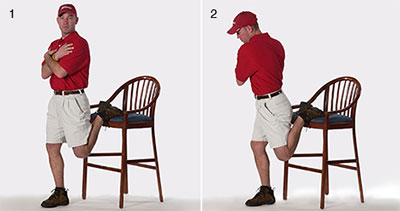
- Stand with your back to a chair or bench and cross your arms over your chest. Place your left foot on the chair or bench (image 1). You can use a chair with a lower seat than the one shown here.
- Keep your left knee even with or behind your right knee. Tighten your left buttock muscles. You’ll feel a stretch in the front of your left thigh.
- To mimic your backswing, rotate your shoulders and torso to the right and bend your left shoulder and trunk slightly toward the ground (image 2).
- Repeat the stretch on the opposite side.
Lower Back
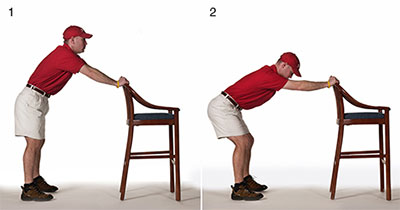
- Stand with your feet apart, facing the back of a chair.
- Grasp the back of the chair with your hands (image 1).
- Holding on to the chair and keeping your spine straight, move your body down and away from your hands until you feel a stretch near both armpits (image 2).
Hamstrings
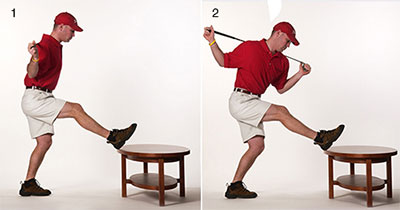
- Hold your golf club behind your shoulders. Stand next to a step, low table or tee bench. Put your right foot on the step and bend your right knee slightly (image 1).
- Bend your upper body forward at your hips, keeping your spine straight until you feel a comfortable stretch in the back of your right thigh.
- Maintain this stretch while rotating your back and shoulders to the left and to the right (image 2).
- Repeat the stretch on the opposite side.
Hips
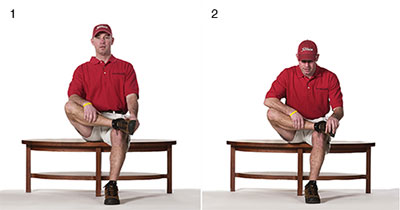
- Sit on a chair, low table or tee bench. Place your right ankle on top of your left thigh (image 1).
- Push down on your right knee with your right forearm. Then lean forward at your waist until you feel a gentle stretch in your right hip (image 2).
- Repeat the stretch on the opposite side.
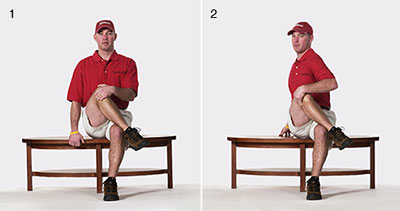
- Sit on a chair, low table or tee bench. Place your right ankle on top of your left thigh. Raise your right knee and grasp it with your left hand (image 1).
- Keeping your spine straight, pull your right knee up toward your left shoulder. You’ll feel a stretch in your right buttock.
- Mimic the position of your right hip when you’re at the top of your backswing by turning your shoulders to the right (image 2).
- Repeat the stretch on the opposite side.
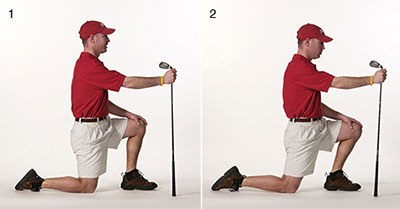
- Kneel on your right knee, holding your golf club with your right hand. Place your left foot in front of you, bending your knee. Place your left hand on your left leg for stability (image 1).
- Keep your back straight and abdominal muscles tight. Lean forward, shifting more weight onto your left leg (image 2). You’ll feel a stretch in the front of your right hip and thigh.
- Repeat the stretch on the opposite side.
Wrists
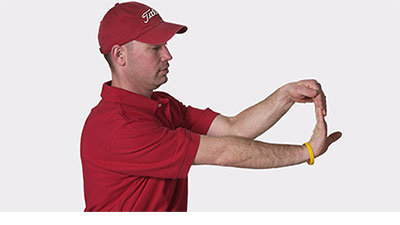
- Hold your right arm in front of you with your palm facing down.
- Keeping your elbow straight, gently pull your wrist up by grabbing the top of your fingers.
- Repeat the stretch on the opposite side.
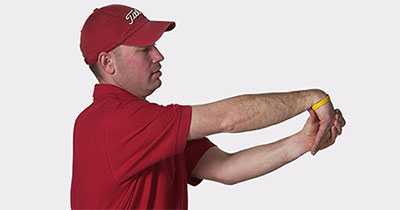
- Hold your right arm in front of you with your palm facing down.
- Keeping your elbow straight, gently pull your wrist down. You’ll feel the stretch in your right forearm and wrist.
- Repeat the stretch on the opposite side.
Shoulder
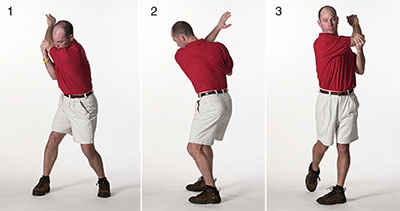
- Stand with your feet shoulder-width apart as though you’re addressing the golf ball. Hold your left elbow with your right hand (image 1).
- Keeping your left thumb pointed up, bend your left wrist toward your left thumb.
- Rotate your trunk to the right.
- Pull on your left elbow until you feel a stretch in your back (image 2).
- To stretch the trailing (right) shoulder, grab your right elbow with your left hand. Then rotate your trunk to the left (image 3).
Core
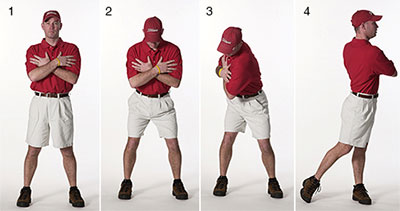
- Stand with your feet shoulder-width apart, and fold your arms across your chest (image 1).
- Bend your knees and lean forward slightly (image 2).
- Rotate your trunk in your backswing motion (image 3).
- Continue from the top of your backswing position to your follow-through (image 4).
- At home, you may want to try this stretch in front of a mirror to check the different positions of your swing.
Other Tips to Prevent Golf Injuries
- Warm up
- Before you practice your swing or play a round of golf, warm up for at least 10 minutes with a brisk walk or a set of jumping jacks.
- Focus on flexibility
- Regular stretching can improve your range of motion and lead to a more fluid golf swing.
- Strengthen your muscles
- You don’t need bulging muscles to hit a long drive — but the stronger your muscles, the greater your club speed. Stronger muscles are also less prone to injury.
- Build up your endurance
- Regular aerobic activity can give you staying power on the course. Try walking, jogging, bicycling or swimming.
- Choose proper footwear
- Dress for comfort and protection from the elements. Wear golf shoes with short cleats. Long cleats dig into the sod and hold your feet planted as you swing, which may strain your knees or ankles.
Bottom Line
- Overuse and poor swing mechanics can take a toll on the golfer.
- Taking lessons with a golf pro will not only help your game, but also greatly reduce your risk of injury.
- Also, take the time to warm up, start slowly and hit the gym to strengthen the muscles.
Images courtesy of Mayo Foundation for Medical Education and Research



Leave a Reply